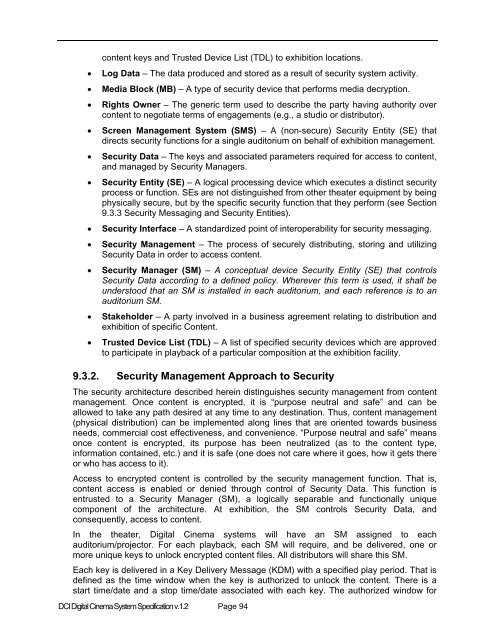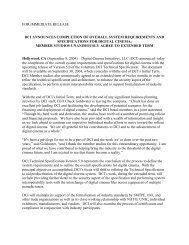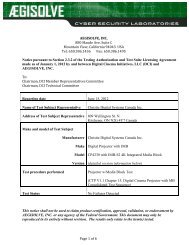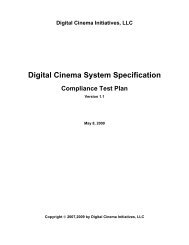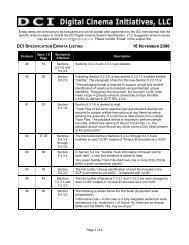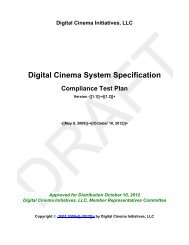DCI Specs - Digital Cinema Initiatives
DCI Specs - Digital Cinema Initiatives
DCI Specs - Digital Cinema Initiatives
You also want an ePaper? Increase the reach of your titles
YUMPU automatically turns print PDFs into web optimized ePapers that Google loves.
content keys and Trusted Device List (TDL) to exhibition locations.• Log Data – The data produced and stored as a result of security system activity.• Media Block (MB) – A type of security device that performs media decryption.• Rights Owner – The generic term used to describe the party having authority overcontent to negotiate terms of engagements (e.g., a studio or distributor).• Screen Management System (SMS) – A (non-secure) Security Entity (SE) thatdirects security functions for a single auditorium on behalf of exhibition management.• Security Data – The keys and associated parameters required for access to content,and managed by Security Managers.• Security Entity (SE) – A logical processing device which executes a distinct securityprocess or function. SEs are not distinguished from other theater equipment by beingphysically secure, but by the specific security function that they perform (see Section9.3.3 Security Messaging and Security Entities).• Security Interface – A standardized point of interoperability for security messaging.• Security Management – The process of securely distributing, storing and utilizingSecurity Data in order to access content.• Security Manager (SM) – A conceptual device Security Entity (SE) that controlsSecurity Data according to a defined policy. Wherever this term is used, it shall beunderstood that an SM is installed in each auditorium, and each reference is to anauditorium SM.• Stakeholder – A party involved in a business agreement relating to distribution andexhibition of specific Content.• Trusted Device List (TDL) – A list of specified security devices which are approvedto participate in playback of a particular composition at the exhibition facility.9.3.2. Security Management Approach to SecurityThe security architecture described herein distinguishes security management from contentmanagement. Once content is encrypted, it is “purpose neutral and safe” and can beallowed to take any path desired at any time to any destination. Thus, content management(physical distribution) can be implemented along lines that are oriented towards businessneeds, commercial cost effectiveness, and convenience. “Purpose neutral and safe” meansonce content is encrypted, its purpose has been neutralized (as to the content type,information contained, etc.) and it is safe (one does not care where it goes, how it gets thereor who has access to it).Access to encrypted content is controlled by the security management function. That is,content access is enabled or denied through control of Security Data. This function isentrusted to a Security Manager (SM), a logically separable and functionally uniquecomponent of the architecture. At exhibition, the SM controls Security Data, andconsequently, access to content.In the theater, <strong>Digital</strong> <strong>Cinema</strong> systems will have an SM assigned to eachauditorium/projector. For each playback, each SM will require, and be delivered, one ormore unique keys to unlock encrypted content files. All distributors will share this SM.Each key is delivered in a Key Delivery Message (KDM) with a specified play period. That isdefined as the time window when the key is authorized to unlock the content. There is astart time/date and a stop time/date associated with each key. The authorized window for<strong>DCI</strong> <strong>Digital</strong> <strong>Cinema</strong> System Specification v.1.2 Page 94


